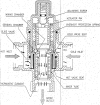Water Temperature From Hot Water Outlets in a Major Public Hospital: How Hot is Our Water?
- PMID: 22184507
- PMCID: PMC3236657
Water Temperature From Hot Water Outlets in a Major Public Hospital: How Hot is Our Water?
Abstract
Objectives: To measure the water temperature issuing from a representative sample of patient-accessible outlets around the Royal Adelaide Hospital. To initiate an audit cycle in the event of unacceptably high water temperatures to ensure their reduction.
Methods: Samples were taken of water issuing from hot taps, showers, and hand hygiene basins in patient areas throughout the hospital, encompassing newly renovated as well as old sections of the hospital. A 45 second "warming" period was followed by hot water collection into a polystyrene cup to 8 cm. The mean of 3 temperatures measured using an infrared thermometer was calculated.
Results: Several taps and patient showers were demonstrated to supply water at a temperature capable of causing scald injuries. Most problem outlets were found in the oldest section of the hospital, fewer in the wing of "intermediate" age and none in the most recently renovated emergency block. The data were tabulated and summarized before being passed on to RAH Engineering and Building Services, which initiated remedial action. Several thermostatic mixing valves were found to be faulty (and replaced) or poorly set (and re-set). After this adjustment, outlets previously supplying excessively hot water were re-tested and found to be safe, closing the audit loop.
Conclusion: Maintenance services infrequently conduct scheduled assessment of hot water outlet temperatures and rely on staff member complaints or concerns to focus their attention on problem areas. With recent evidence of the disastrous potential of hot water on a vulnerable population of hospital in-patients, hazard identification and reporting is everybody's responsibility.
Figures


Similar articles
-
Randomised controlled trial of thermostatic mixer valves in reducing bath hot tap water temperature in families with young children in social housing: a protocol.Trials. 2008 Mar 19;9:14. doi: 10.1186/1745-6215-9-14. Trials. 2008. PMID: 18348736 Free PMC article.
-
Scald prevention campaigns: do they work?J Burn Care Res. 2007 Mar-Apr;28(2):328-33. doi: 10.1097/BCR.0B013E318031A12D. J Burn Care Res. 2007. PMID: 17351454
-
Prevention of hot tap water burns--a comparative study of three types of automatic mixing valve.Burns. 1993 Feb;19(1):56-62. doi: 10.1016/0305-4179(93)90102-e. Burns. 1993. PMID: 8435118
-
Hygiene and emollient interventions for maintaining skin integrity in older people in hospital and residential care settings.Cochrane Database Syst Rev. 2020 Jan 23;1(1):CD011377. doi: 10.1002/14651858.CD011377.pub2. Cochrane Database Syst Rev. 2020. PMID: 32006460 Free PMC article.
-
[Hygienic problems of hot water supply for the population].Gig Sanit. 2012 Mar-Apr;(2):4-8. Gig Sanit. 2012. PMID: 22834255 Review. Russian.
References
-
- Water SA. Plumbing solutions—edition 9: temperature control for hot water delivery. Updated 2003. Accessed July 25, 2011. Available at: http://www.sawater.com.au/NR/rdonlyres/AE81FB09-363B-47EE-9D6A-D13B5A761....
-
- Marchesi I, Marchegiano P, Bargellini A, et al. Effectiveness of different methods to control legionella in the water supply: ten-year experience in an Italian university hospital. J Hosp Infect. 2010;77(1):47–51. - PubMed
LinkOut - more resources
Full Text Sources
